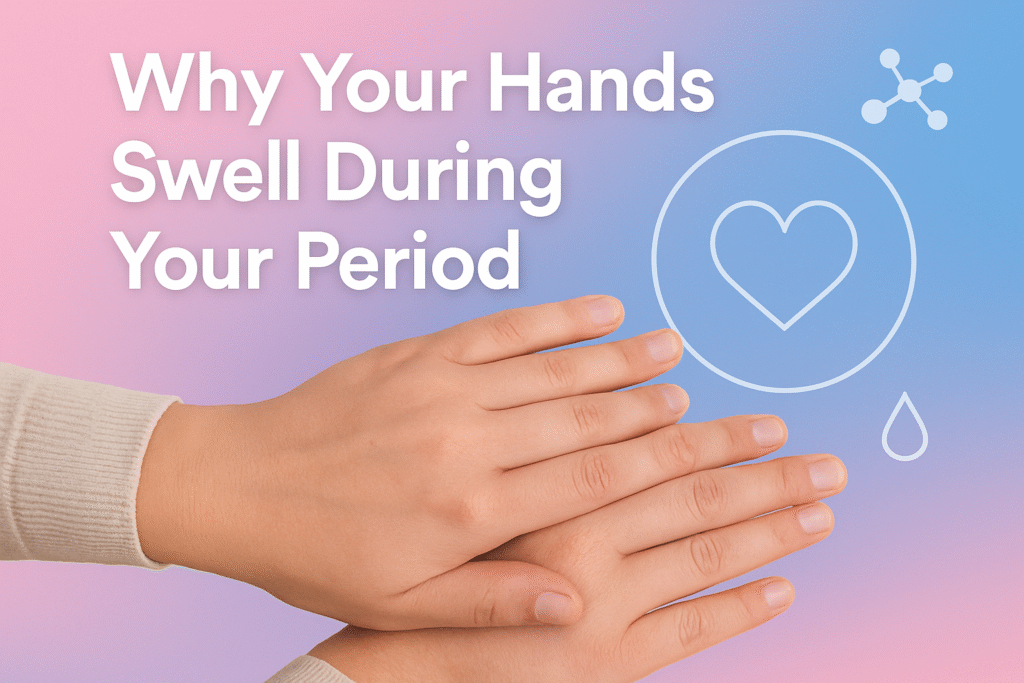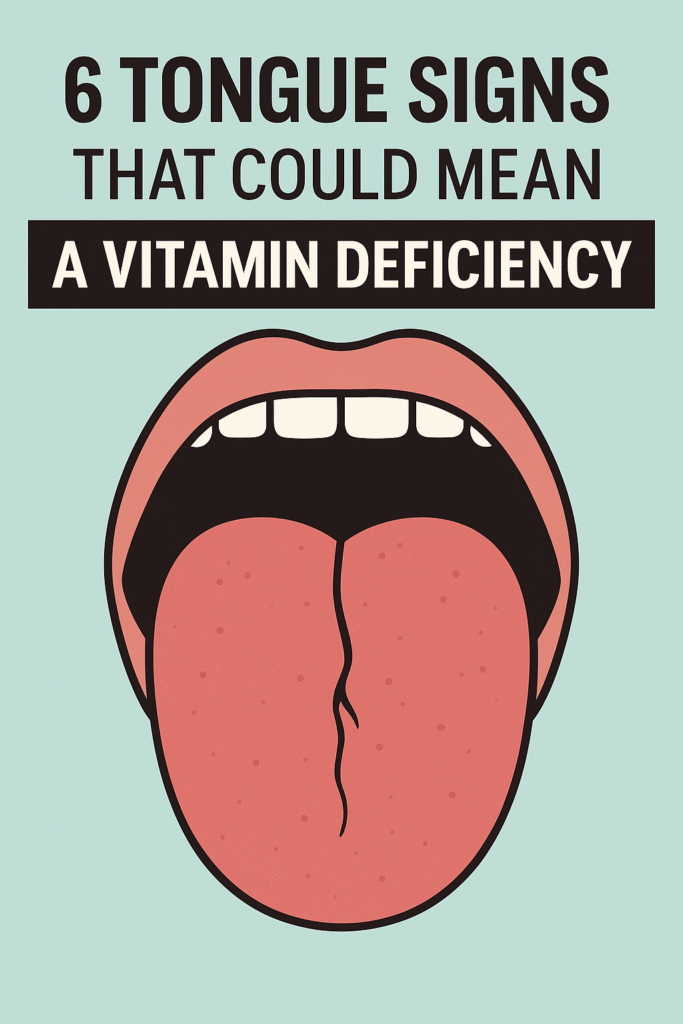
⚠️ Affiliate Disclaimer: This post may contain affiliate links, which means I may earn a small commission — at no extra cost to you — if you make a purchase through one of these links. I only recommend products or services I genuinely trust and believe can provide value. Thank you for supporting My Medical Muse!
Why Your Hands Swell Before or During Your Period (and When to Worry)
Have you ever noticed your rings feeling tight or your fingers looking puffier right before or during your period? You’re not imagining it. Hand swelling or premenstrual edema is a surprisingly common symptom during menstruation, affecting millions of women every month.
Although it can be annoying (and sometimes uncomfortable), this swelling usually isn’t dangerous. It’s your body’s way of reacting to hormonal changes and fluid shifts that happen throughout your cycle but when swelling becomes severe or persistent, it may signal an underlying issue worth checking out.
In this post, we’ll break down why your hands swell during your period, what’s normal, when to worry and most importantly what you can do to reduce the puffiness and feel better fast.
1. The Role of Hormones: Estrogen and Progesterone in Water Retention
Your menstrual cycle runs on two powerhouse hormones, estrogen and progesterone. Beyond controlling ovulation and mood, these hormones significantly affect how your body manages sodium, water, and fluid balance.
How It Works
During the luteal phase (the two weeks before your period), both estrogen and progesterone levels rise in preparation for a possible pregnancy. Estrogen in particular causes your kidneys to retain sodium. Wherever sodium goes, water follows leading to subtle but noticeable fluid buildup throughout the body.
This retention explains why many women experience bloating, breast tenderness, or swelling in their hands, feet, and face in the days leading up to menstruation. When your period begins both hormone levels drop sharply. Your body then starts releasing the stored water but this process takes a few days which is why swelling often persists slightly into the first days of bleeding.
Why It Affects Your Hands
Your hands and fingers have abundant soft tissue and small blood vessels that easily trap fluid. When your body holds on to extra water, these areas swell more visibly than others. You may notice:
Rings that suddenly feel tight
Fingers that look puffy or stiff, especially in the morning
A mild tingling sensation or reduced flexibility when making a fist
Fortunately, this type of swelling is temporary and harmless. As hormone levels stabilize and your kidneys rebalance sodium, the puffiness fades naturally usually within two to three days after your period begins.
2. Sodium, Water, and Bloating: The Hidden Dietary Link
Hormones may trigger water retention, but your diet determines how strongly you feel it. During PMS, your body becomes hypersensitive to sodium, even moderate salt intake can cause noticeable bloating or swelling. That’s why salty or processed foods such as chips, canned soups, instant noodles, or deli meats can make your hands puff up more than usual right before or during your period.
Other Dietary Triggers:
Several common foods and drinks can worsen fluid retention:
Caffeine: While it acts as a mild diuretic at first, it can cause rebound water retention once its effect wears off.
Sugar: High sugar intake spikes insulin levels, which prompts the kidneys to retain more sodium leading to bloating.
Alcohol: Initially dehydrates you, but your body overcompensates afterward by holding onto water, worsening puffiness.
You don’t have to cut salt entirely, but keep daily sodium intake under 2,300 mg (about one teaspoon). Focus on whole foods, fruits, vegetables, lean proteins, and whole grains while minimizing packaged snacks and here’s the counterintuitive part, drink more water, not less. Hydration signals your body that it doesn’t need to hoard fluid, allowing it to flush out sodium and excess water naturally.
3. PMS, Inflammation, and Circulation
PMS is more than just emotional swings and cravings, it involves systemic, low-grade inflammation that peaks in the days before menstruation. This inflammation increases capillary permeability, meaning that tiny blood vessels become “leakier.” As a result, fluid seeps into surrounding tissues, particularly in the hands and feet.
Why Poor Circulation Makes It Worse
If your job or lifestyle involves long hours of sitting or inactivity, circulation slows down and fluid can pool in your extremities. This amplifies swelling and creates sensations like:
Heaviness or tightness in your hands
Warmth or mild throbbing in swollen fingers
Morning puffiness that improves as you start moving around
Simple Ways to Boost Circulation
Move every hour: Stand, stretch, or walk for a few minutes to keep blood and lymph flowing.
Rotate your wrists: Small circular motions help stimulate microcirculation.
Open and close your fists: Do 10-15 gentle squeezes to prevent stiffness.
Try hand soaks or massages: Warm water with Epsom salts or gentle upward strokes toward your wrists can help drain excess fluid.
Improving circulation isn’t just cosmetic, it supports lymphatic drainage and reduces overall PMS discomfort, including bloating and fatigue.
4. Why Swelling Is Often Worse at Night or in the Morning
If your hands look puffiest when you wake up, that’s not a coincidence. During sleep, your body is horizontal, and gravity no longer draws fluid toward your legs. Instead, it redistributes evenly often collecting in your hands and face. Add hormonal water retention into the mix, and you have the perfect setup for morning puffiness. The effect tends to improve within a few hours as you start moving, your heart rate increases, and fluids shift back down toward your lower body.
How to Minimize Morning Hand Swelling
Elevate your hands while sleeping: Place a small pillow or rolled towel under your arms to help fluid drain overnight.
Avoid high-sodium meals or desserts late in the evening: Salt and sugar before bed increase overnight water retention.
Hydrate before sleep: A glass of water helps maintain fluid balance and encourages the kidneys to flush sodium during the night.
Do gentle morning stretches: Wrist circles, arm lifts, or light yoga poses can stimulate circulation and reduce puffiness quickly.
Consistent small habits like these can significantly reduce how swollen your hands feel during your cycle, especially in the mornings.
5. The Estrogen-Renin-Aldosterone Connection
This one’s a bit technical but fascinating and it’s one of the most important reasons your hands swell during your period.
Estrogen doesn’t just regulate your menstrual cycle, it also influences a hormone system deep inside your body called the Renin-Angiotensin-Aldosterone System (RAAS). This network controls blood pressure and fluid balance.
How the RAAS Works
When RAAS is activated:
Renin, released by the kidneys, triggers a chain reaction that produces angiotensin II, a hormone that tightens blood vessels.
Angiotensin II then stimulates aldosterone, which tells your kidneys to hold onto sodium.
Sodium retention leads to water retention, which increases overall body fluid volume.
How Estrogen Triggers It
During certain points in your cycle, particularly before ovulation and in the days before your period estrogen levels rise. This surge amplifies RAAS activity, making your kidneys more likely to retain sodium and water.
The result? Subtle puffiness or bloating that can show up as swollen hands, fingers, or feet. When your period begins, estrogen levels fall, RAAS quiets down, and your body starts flushing out the stored water naturally. Understanding this mechanism helps explain why hand swelling follows a predictable hormonal pattern for many women.
6. Exercise and Activity Levels Matter
Your daily movement has a direct effect on how efficiently your body circulates and drains fluids. Physical activity isn’t just good for your muscles, it’s essential for maintaining lymphatic flow, which prevents fluid buildup in tissues.
When You’re Less Active
It’s common to feel tired, crampy or sluggish before and during your period but when you move less, blood and lymph circulation slow down, allowing fluid to pool in your hands, feet, and lower legs. This can cause noticeable swelling and stiffness, especially after long periods of sitting or sleeping.
When You Exercise Regularly
Regular movement counteracts swelling by improving circulation and helping the lymphatic system flush out waste and excess water. You don’t need to push hard, gentle, low-impact activity works wonders.
Great options include:
Brisk walking or light jogging
Yoga or Pilates
Stretching sessions
Simple upper-body movements (arm raises, wrist rolls, or hand stretches)
Try This Quick Anti-Swelling Routine
Do this short set whenever your hands feel tight or puffy:
Shake out your hands for 30 seconds to boost blood flow.
Stretch your arms overhead to help fluid drain toward your core.
Make circular wrist motions, 10 in each direction.
Squeeze and release your fists 10 times to engage the small muscles.
These simple motions stimulate the hand’s microcirculation. You’ll often feel noticeable relief within minutes.
7. Emotional Stress and Cortisol Retention
Stress doesn’t just affect your emotions, it has powerful physical effects that can worsen swelling during your period.
When you’re stressed, your adrenal glands release cortisol, often called the “stress hormone.” While short-term cortisol helps your body cope, chronic stress or emotional tension keeps cortisol levels elevated.
How Cortisol Causes Swelling
Cortisol acts a lot like aldosterone, it tells your kidneys to retain sodium and water. During PMS, your hormone levels are already fluctuating, adding stress to the mix amplifies fluid retention, bloating and that uncomfortable “puffy” feeling in your hands.
How to Reduce Cortisol Naturally
Balancing stress hormones takes consistent care. Try:
Deep breathing or mindfulness for 5-10 minutes daily.
Gentle yoga or stretching in the evening to relax muscles and improve circulation.
Adequate sleep (7-8 hours) to restore adrenal balance.
Light exercise: Walking or dancing to burn off tension and lower cortisol.
Even small changes in your daily rhythm can dramatically reduce stress-related swelling and help your body feel more balanced throughout your cycle.
8. Nutritional Deficiencies That May Contribute
Your nutrient intake directly affects how your body handles fluids. Deficiencies in certain vitamins and minerals can make swelling and bloating more intense during your period.
Key Nutrients for Fluid Balance
Magnesium:
Acts as a natural diuretic by improving kidney function and helping the body release sodium.
Reduces PMS-related bloating, cramps, and hand puffiness.
Vitamin B6 (Pyridoxine):
Helps the body convert stored glycogen and manage sodium-water balance.
Studies show that adequate B6 can reduce PMS symptoms, including swelling.
Potassium:
Counteracts sodium by promoting water excretion through urine.
Essential for maintaining electrolyte balance and smooth muscle function.
Foods That Help
Incorporate nutrient-dense, anti-bloating foods such as:
Bananas, avocados, and sweet potatoes (potassium)
Spinach, almonds, pumpkin seeds, and dark chocolate (magnesium)
Chickpeas, tuna, poultry, and sunflower seeds (vitamin B6)
If your diet lacks these nutrients, you can consider supplements but always consult a healthcare provider first. Research suggests that taking Magnesium (200-400 mg daily) and Vitamin B6 (50-100 mg daily) can noticeably reduce PMS-related water retention and discomfort.
Balanced nutrition not only helps with swelling but also stabilizes mood and energy levels throughout your cycle.
9. Medications That Can Worsen Swelling
Certain medications can unintentionally increase water retention, making hand swelling more noticeable during your period.
Common Culprits:
Estrogen-based birth control pills: These mimic natural estrogen, which can trigger sodium and fluid retention, particularly in the first few months of use.
NSAIDs (nonsteroidal anti-inflammatory drugs) such as ibuprofen: While helpful for cramps, frequent or high doses can affect kidney function and disrupt your body’s water balance.
Corticosteroids: Medications like prednisone mimic cortisol and may cause puffiness, especially around the hands and face.
What to Do
If you notice persistent swelling after starting a new medication:
Don’t stop it abruptly speak with your healthcare provider first.
Ask if there are lower-dose or non-hormonal alternatives.
Maintain hydration and limit salt to offset fluid retention.
Your doctor can help identify whether the swelling is a side effect or related to your menstrual cycle.
10. When Swelling Might Signal a Health Issue
Most menstrual hand swelling is harmless and short-lived, but sometimes it can point to underlying medical conditions. Recognizing when to seek help is important.
Red Flags to Watch For:
Swelling that doesn’t resolve within a week after your period
Pain, redness, or warmth around the swollen area (possible infection or inflammation)
Tingling, numbness, or weakness (could indicate carpal tunnel syndrome or nerve compression)
Only one hand swollen (may suggest vascular or lymphatic blockage)
Possible Underlying Conditions
Thyroid disorders: Low thyroid function (hypothyroidism) can slow metabolism and cause generalized puffiness.
Kidney or liver issues: Both organs regulate fluid balance; dysfunction can cause persistent swelling.
Carpal tunnel syndrome: Hormonal swelling can worsen nerve compression in the wrist, especially around menstruation.
Lymphedema: Impaired lymph drainage leads to chronic, one-sided swelling.
When to See a Doctor
If swelling becomes painful, persistent, or asymmetrical, schedule a medical evaluation. Your doctor may recommend:
Blood tests to assess hormone, thyroid, or kidney function
Urine analysis for sodium or protein levels
Ultrasound or imaging to check circulation and tissue fluid
Early assessment ensures that the swelling is truly hormonal, not a sign of an underlying health issue and helps you find the most effective, personalized treatment.
Natural Ways to Reduce Hand Swelling During Your Period
Luckily, you can take steps to manage swelling without relying on medication. Here are science-backed, easy-to-implement strategies:
Stay Hydrated
Drink at least 8-10 cups of water daily. When you’re dehydrated, your body holds onto water, ironically making swelling worse.
Limit Salt and Processed Foods
Avoid canned soups, packaged snacks, and takeout foods high in sodium. Aim for whole foods like fruits, vegetables, lean proteins, and whole grains.
Elevate Your Hands
Raise your hands above heart level for 10-15 minutes a few times daily to help drain excess fluid.
Massage and Stretch
Massage your hands gently toward your wrists and elbows to promote lymph flow. Add light stretching throughout the day.
Try Herbal Teas
Herbal teas like dandelion root, parsley, or green tea have mild diuretic properties and can reduce fluid retention naturally.
Track Your Cycle
Keep a period journal or use a cycle-tracking app to note when swelling tends to occur. This helps you anticipate symptoms and make preventive lifestyle changes.
When Hand Swelling Becomes Part of PMS (and PMDD)
For some women, swelling isn’t just a minor nuisance, it’s part of PMS (Premenstrual Syndrome) or PMDD (Premenstrual Dysphoric Disorder).
PMS-Related Swelling
Typically mild and limited to a few days before menstruation.
PMDD-Related Swelling
Can be more intense, lasting longer and accompanied by:
- Severe mood swings
- Fatigue
- Digestive discomfort
- Painful bloating
In such cases, a healthcare provider might recommend:
- Lifestyle changes (low-salt diet, regular exercise)
- Diuretics (prescription water pills, if necessary)
- Hormonal therapy to balance estrogen and progesterone
The Mind-Body Connection: Accepting Cycle Changes
It’s easy to get frustrated when your body feels puffy or sluggish, but remember, swelling is a temporary response, not a reflection of your health or fitness.
Learning to understand and support your body during each phase of your cycle can make a big difference. Small changes like drinking more water, getting enough rest and reducing stress can help you feel more in sync with your body instead of fighting against it.
Key Takeaways
Cause | Why It Happens | What Helps |
Hormonal changes | Estrogen and progesterone affect sodium balance | Stay hydrated, reduce salt |
Poor circulation | Blood and lymph fluid pooling | Exercise, stretch, elevate hands |
PMS inflammation | Increases fluid leakage into tissues | Anti-inflammatory foods, rest |
Diet and lifestyle | Too much salt, caffeine, or sugar | Whole foods, balanced diet |
Stress (cortisol) | Triggers extra water retention | Relaxation, deep breathing |
Deficiencies | Low magnesium or potassium | Nutrient-rich foods, supplements |
When to See a Doctor
See your doctor if:
- Swelling lasts more than 7 days
- One hand is consistently larger or painful
- You notice tingling, numbness, or weakness
- You develop swelling outside your period
They may recommend tests like:
- Blood work (to check hormones, kidney, or thyroid function)
- Urine analysis (for sodium or protein levels)
- Imaging (if circulation or nerve issues are suspected)
Early detection helps rule out serious causes and ensures your swelling is truly menstrual-related.
Final Thoughts
Swelling in your hands during your period might feel uncomfortable, but in most cases, it’s a normal and temporary part of your body’s hormonal rhythm.
Understanding how hormones, diet, stress, and circulation interact gives you the power to manage the symptoms naturally, with the right balance of hydration, nutrition, and movement, you can minimize swelling and move through your cycle feeling lighter, healthier, and more in control.
Your body is constantly working to maintain balance, be patient, kind, and supportive of it even when your hands feel a little puffier than usual.
👩⚕️ Need Personalized Health Advice?
Get expert guidance tailored to your unique health concerns through MuseCare Consult. Our licensed doctors are here to help you understand your symptoms, medications, and lab results-confidentially and affordably.
👉 Book a MuseCare Consult NowRelated Blog Post You Might Like:
- Why Do My Hands Swell in the Morning? 9 Surprising Reasons & Simple Fixes
- 10 Proven Ways to Reduce Swelling in Ankles at the End of the Day
- 7 Interesting Reasons Why Your Body Feels Heavy Before Your Period and Why It’s Totally Normal
- 7 Powerful Reasons Why You Are Craving Salt and What Your Body Is Trying To Tell You
- 7 Surprising Reasons Why Your Body Temperature Keeps Changing Randomly
- Why Your Legs Feel Cold but Your Body Feels Hot: 9 Hidden Reasons and What to Do


